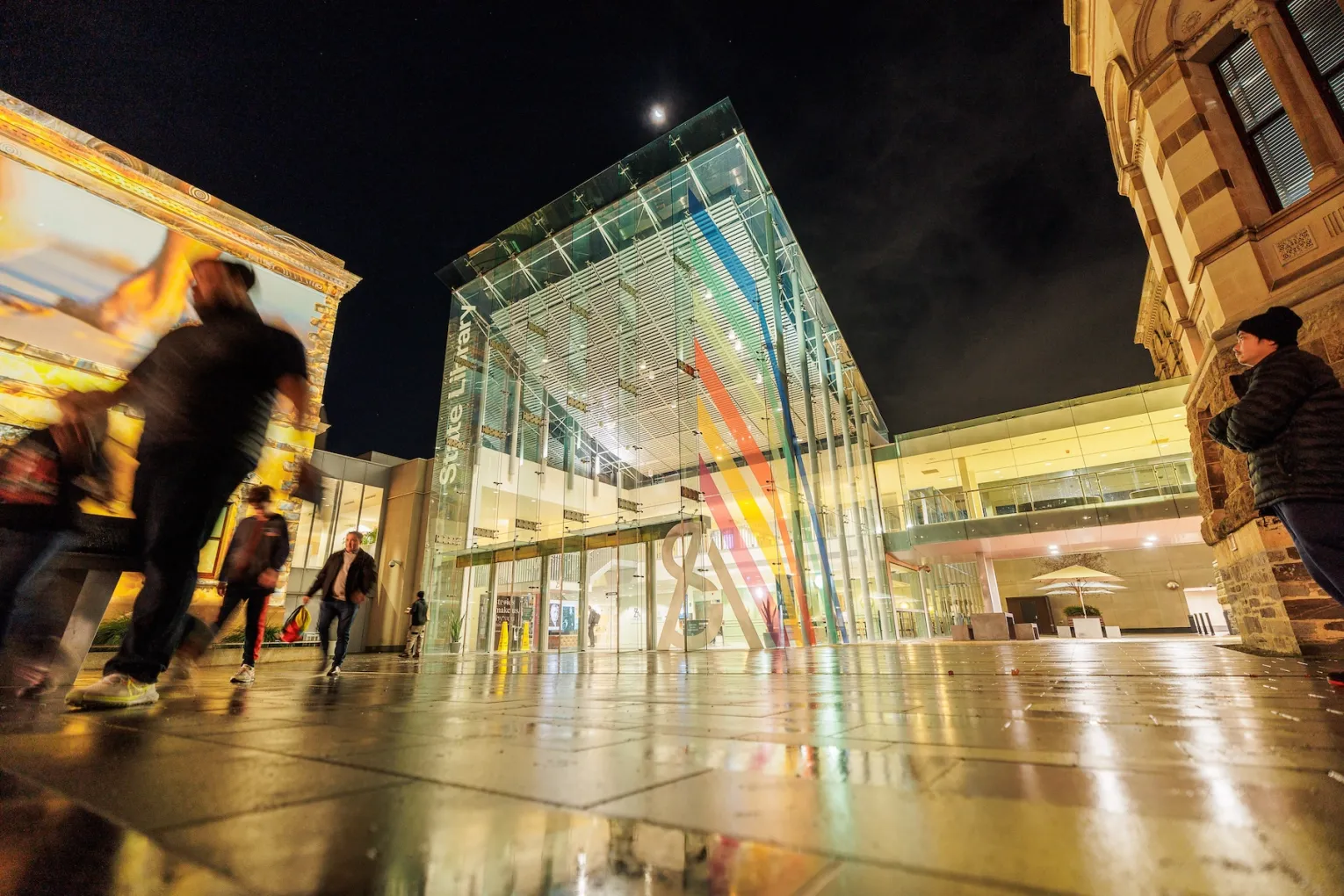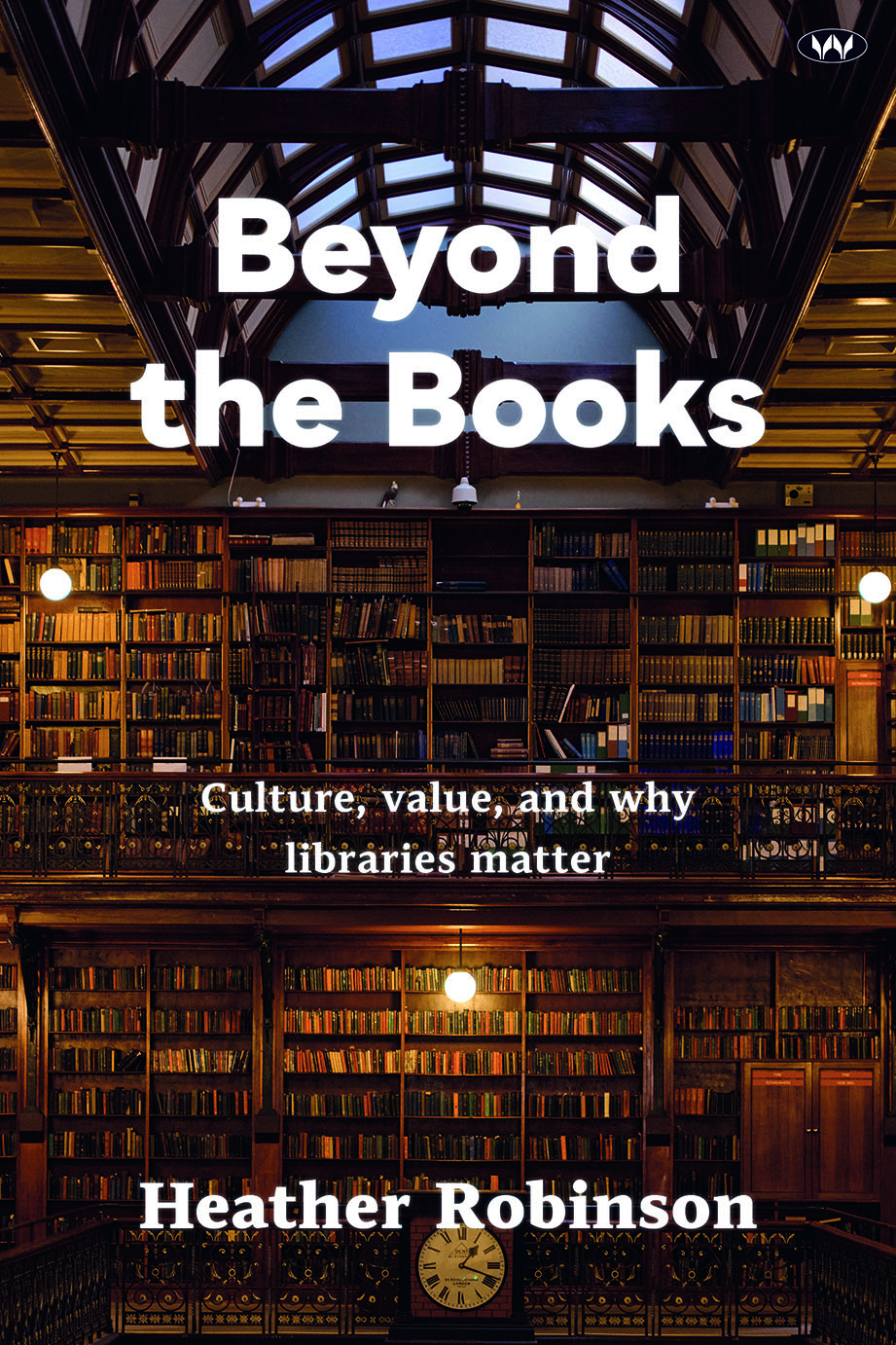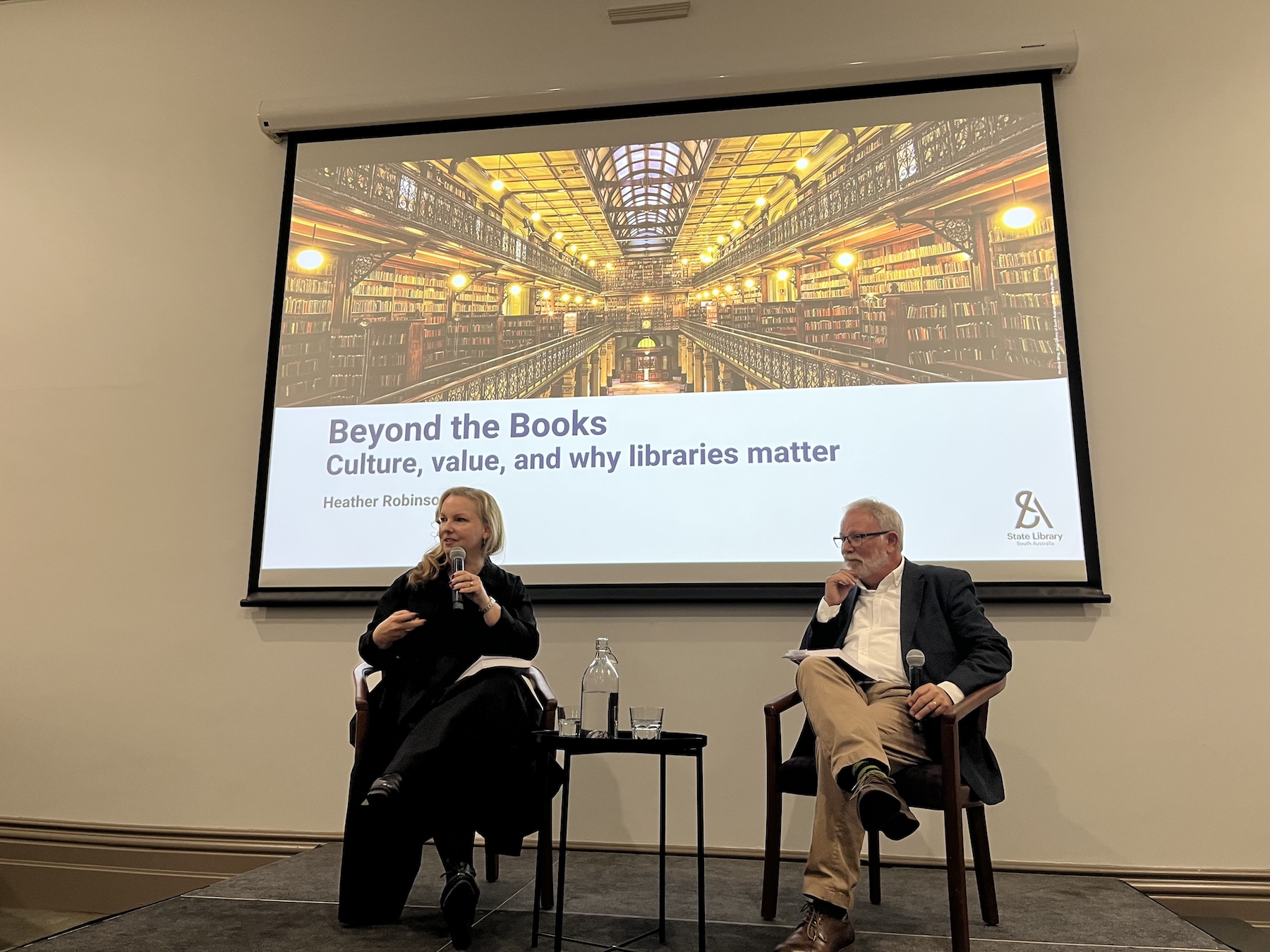Has a ‘neoliberal’ festival fixation undercut our cultural community?
In this extract from her book Beyond the Books: Culture, value, and why libraries matter, writer and researcher Heather Robinson reflects on how the rise of an economically driven ‘Festival State’ risks leaving vital institutions out of the conversation.

Since the early 1990s, the South Australian Government has considered the arts sector an industry, one whose role is to contribute to the state economy, with somewhat less regard for ‘the essential nature of arts and cultural activities or of their broader social role’. In recent decades, several studies and sector-wide consultations have been conducted to address the role of the arts and culture in the state’s development. Unfortunately, as Jo Caust describes, these initiatives ‘did not necessarily translate into promoting arts practice or arts development’. Instead, since the 1990s, the South Australian policy-makers decided that Adelaide would be positioned both publicly and politically as a ‘cultural destination’ rather than ‘a cultural producer’. The state’s funding arrangements and cultural infrastructure have subsequently been geared towards importing national and international acts, artists and experiences, rather than developing an authentic local cultural identity and audience for and within the state.
Hence, South Australia is promoted as the ‘Festival State’: a dazzling array of festival options are on offer, largely featuring imported acts, usually happening simultaneously. This festival calendar is designed to maximise marketing and tourism opportunities to showcase the best of the state for visitors. The numbers of travellers arriving at the airport rise, while bookings at restaurants and hotels skyrocket, all of which represent commendable numbers of visitors seeking an enriching art experience. Notably, these figures are also easily counted and recalculated to reflect a return on the government investment. If only it were as simple as that to quantify the impact of the Library.
As in the health and education sectors, there is a growing expectation that the South Australian cultural sector will deliver instrumental benefits, particularly economic and social impacts, as evidence of success and value, an expectation made explicit in the ‘SA Arts Plan 2020–2024’. Following months of detailed consultation and submissions from across the sector, it was proposed that arts and cultural organisations, including the State Library, will ‘take a whole-of-government’ approach to ensure that the benefits of the arts ‘are able to be realised across the range of sectors where the community interacts with government’. No additional funding was allocated to realise this goal.
Ergo, the cultural sector is again expected to do more with less. To make up the shortfall, the arts plan encouraged the sector to explore opportunities ‘facilitating engagement between Arts and other government departments, particularly Tourism, Multicultural Affairs, Communities and Education, along with other levels of Government and also the corporate and philanthropic sectors’. These strategic policy goals have little to do with creative or cultural practice; they lack qualitative nuance and are beyond the operational capacity of institutions already running on reduced budgets.

Since the introduction of the arts plan in late 2019, the cultural sector in South Australia has been in transition. The plan, which is notable as much for its positive appraisal of the sector’s potential as for the lack of funding to realise it, could not have anticipated a global pandemic.
You might like
As seen across the globe, the impacts on the South Australian creative sector were immediate. Given the years of budget cuts and diminished ministerial backing, few resources were available to see many in the sector through the crisis. Policy decisions made before the pandemic led to the dismantling of Arts South Australia, the department for the arts. The essential expertise had already been lost, and other voices had greater claim on the public purse. The responsibility for managing state cultural institutions was absorbed into the Department of Premier and Cabinet. That said, during the pandemic, it was the health, education, and the cultural sectors – essential community services – that rallied to adapt and maintain some sense of normalcy and connection for the public.
Perhaps it is an old-fashioned concept, but most arts professionals and volunteers I have worked alongside are motivated to contribute to the ‘public realm’ through their personal preference, professional interest and love of the arts. The public realm, or common ground, is used for the engagement, leisure and pleasure of the public, but it is also where people become active citizens within a democracy, not merely consumers.
This places us at odds to some of the behavioural assumptions that underpin cultural policy and market economics. We don’t contribute our time, intellects and labour primarily for the money – we do it for the public good, and to share our love of cultural collections and experiences. These are significant motivations for people drawn to cultural vocations, such as those who become librarians. Nevertheless, even though we don’t pursue these careers for financial gain alone, the cultural sector makes a significant contribution to the federal economy. Research conducted in support of the Australian Federal Government’s Revive arts policy found that cultural and creative activity contributed $63.7 billion to the Australian economy, or 2.5% of Australia’s GDP in 2022-23. These are good numbers. As we will explore in the coming chapters, that economic impact is not the only return on government investment.
"The ramifications of South Australia’s outdated and underfunded cultural policy decisions have been devastating for the local sector, both major and emerging organisations alike."
The ramifications of South Australia’s outdated and underfunded cultural policy decisions have been devastating for the local sector, both major and emerging organisations alike. Perhaps the biggest losers, though, are local audiences. Without reliable and substantive funding in recent years for local infrastructure and development strategies for local audiences and artists, South Australian stories rarely make it into the public domain.
It must be challenging to be a local institution of any scale in a state that prides – if not defines – itself according to its festival calendar. Adelaide’s festivals are indeed wonderful experiences: world-class, well-marketed, pre-packaged forms of entertainment. We are lucky to have them. It’s difficult not to enjoy such high-quality, well-promoted world-class encounters. For most of the year, however, local South Australian companies such as the Adelaide Symphony Orchestra and State Theatre Company compete for access to venues, sponsorship and marketing budgets.
Subscribe for updates
Without funding for appropriate infrastructure and the promotional power that comes with government investment, local productions that do get off the ground struggle to register with potential local and interstate audiences. Unfortunately, what this well-established emphasis on major festivals has created is a city in which, for many, culture and the arts have become a special event for certain times of the year, separated from normal life; something contained (you could say ‘regulated’) and ultimately tied and measured by economic rather than unique artistic outcomes.
"Unfortunately, what this well-established emphasis on major festivals has created is a city in which, for many, culture and the arts have become a special event for certain times of the year, separated from normal life."
Festivals, by their nature, have a sporadic and hedonistic relationship with the public. They are created as a form of fleeting entertainment rather than as a tool for the cultural or artistic development of a specific community over time. Consequently, the success of a festival is also easily measured. Individual artists or performers may indeed tackle contentious societal topics or challenge public figures, but how many of them directly address the local South Australian case?
In the 1970s, cultural historian Derek Whitelock wrote that ‘Adelaide people take themselves, their city and their Festival rather seriously. Many of them feel themselves to be experts in the arts, or at least on the Festival.’ Many would agree that this passion for the festivals is as strong today as it was 50 years ago. The pre-eminence of the Adelaide Festival and, increasingly, the Adelaide Fringe in the South Australian cultural ecology is attributable to the decades-old government arts policies continuing into the twenty-first century.

The rise of festivals to cultural dominance in Adelaide’s cultural landscape coincided with the rise of neoliberalism, evidence-based arts policy-making and the ‘crisis’ of cultural value experienced by collecting institutions. Collections-based organisations such as museums, libraries and galleries operate continuously and over decades. They are destination institutions throughout the year and curate, exhibit and conserve both physical and intangible items in perpetuity. Although they do have goals associated with occasional events, their continuity and service-based relationship with the public mean that economic measures are an uncomfortable fit. Furthermore, the impact of public investment made today may not be evident for some time. These organisations are often quiet reflective places, filled with people reading or talking in whispers amongst objects that require careful handling and the complex specialist knowledge of experts to curate, research and conserve over decades.
By comparison, festivals – discrete, readily measurable – fit the economic rationalist mindset: numbers through the door, ticket sales data, media spend, tourism visitor data and social network hits all mean that festivals are relatively simple to evaluate. These quantitative indicators provide an impression of both social and economic impact – outputs and outcomes – which funding bodies consider to be markers of success and evidence of return on investment. Good numbers and much easier to show on a spreadsheet. The relationship between the public and the State Library of South Australia is entirely different from the relationship between a festival and its audience, a factor that could easily be overlooked or at least misunderstood when assessing the two types of cultural investment (festivals vs state cultural institutions) via the same quantitative reporting techniques.
The public’s relationship with the State Library and the state’s other cultural institutions – and how they perceive and value their experiences – extends well beyond the books, the artefacts, the artworks and the buildings, and into the city around them. As I’ve found, to appreciate the value of this relationship takes a lot of work and an entirely different approach. Communities of shared meaning and creativity form within and around the bricks-and-mortar of cultural institutions. Understanding is born through recognition of shared values. Across Australia, and indeed worldwide, the experience of individuals collectively supports both major cultural institutions and smaller local arts organisations, ‘bringing them to life’ and releasing their ‘capacity for shared meaning making’.
The prioritisation of tourist numbers and the estimated economic impact in reporting and evaluation clouds the public and political perception of what also matters: the positive social, cultural, and creative benefits for the people who live, work and dream in South Australia. The evaluation procedures imposed by governments on both festivals and institutions exemplify commercially driven numbers-based approaches, which ‘equate value creation predominantly with profit rather than society’. This jeopardises institutions’ ability to convey the value and meaning delivered for their users, irrespective of the numbers that come through the door or login online. If quantifiable estimates and outcomes are all that seem to count, how can we communicate the State Library’s role, meaning and value to the community it serves throughout the year in a way that will also make sense to the decision-makers who hold its future in their hands?
Without a narrative context to balance the numbers, most of the story is lost.
Beyond the Books: Culture, value, and why libraries matter (Wakefield Press) is out now
Heather Robinson is a writer and researcher specialising in the cultural history of the twentieth century. She is also a creative producer with thirty years of experience across the Australian GLAM sector and public service. In 2020, Robinson completed a PhD at Flinders University, exploring the creative industries policy impacts on cultural institutions and their communities. She is an Honorary Research Associate of Flinders University and the Los Angeles County Museum of Natural History, an avid reader, Darwinian gardener, and passionate motorcyclist.
Free to share
This article may be shared online or in print under a Creative Commons licence

